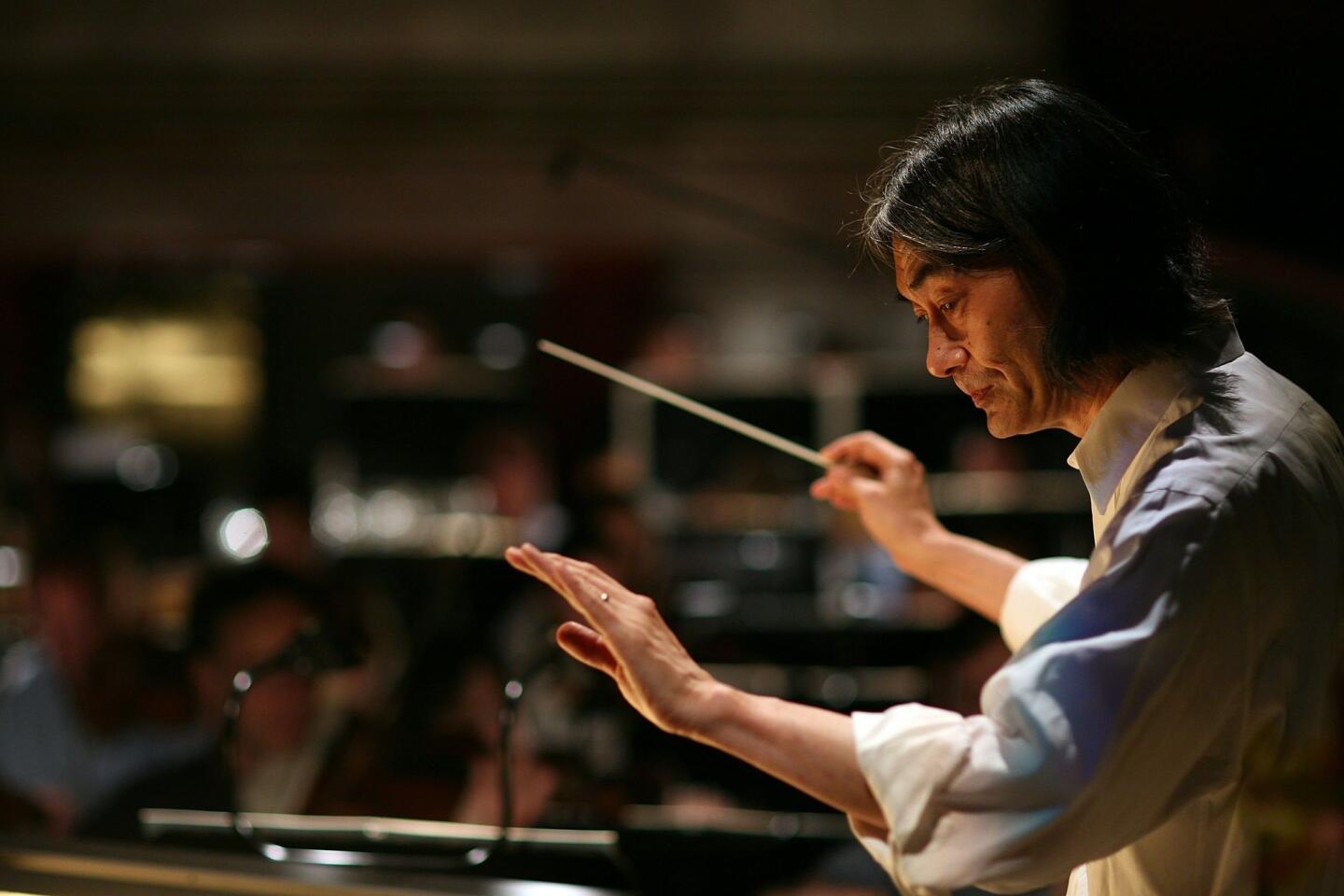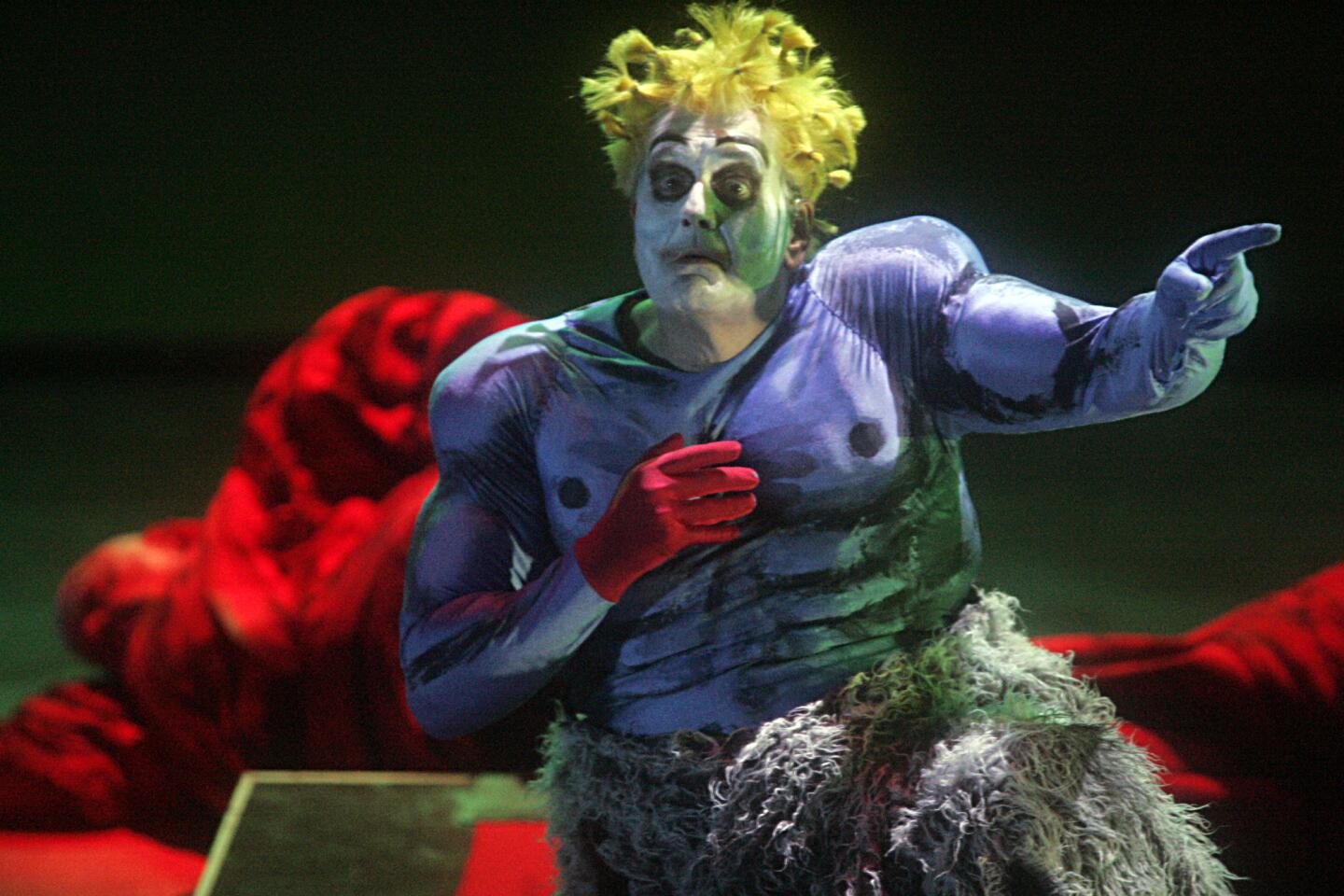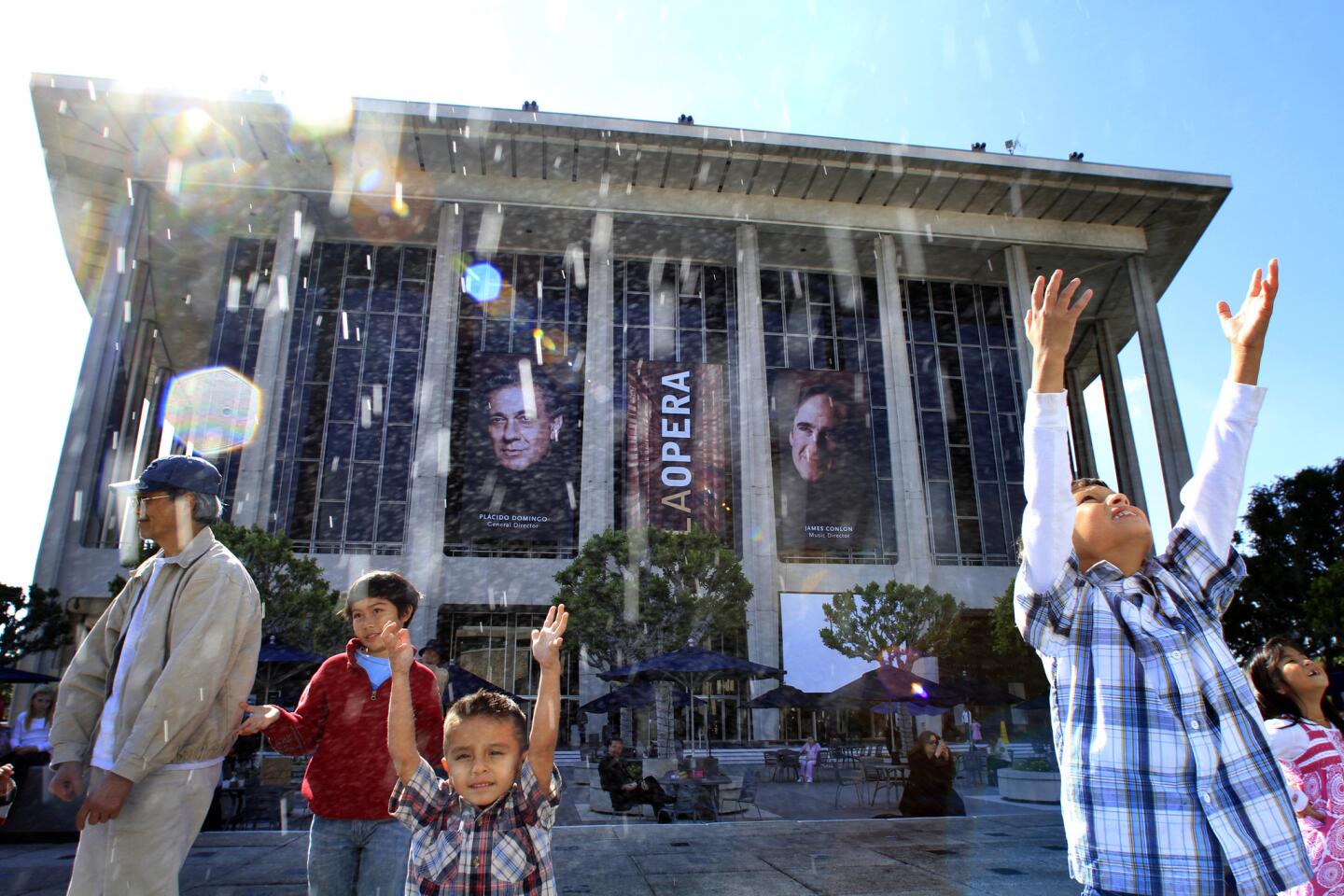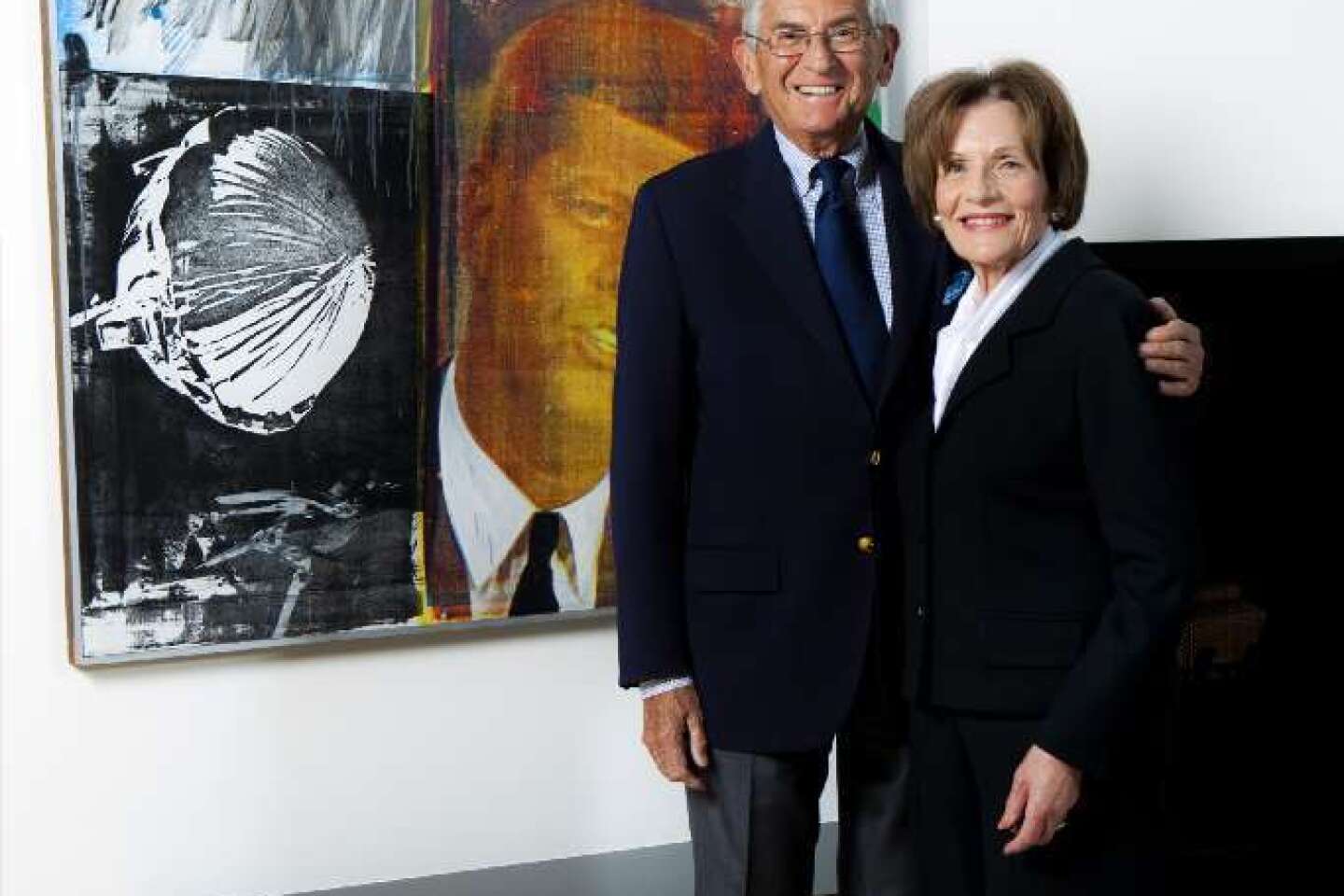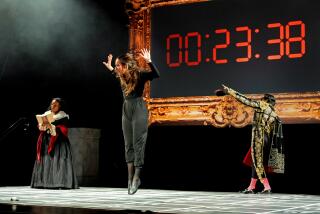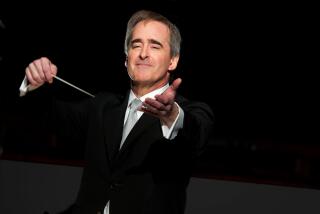L.A. Opera to import a ‘Magic Flute’ influenced by silent films
Having developed a momentary case of the 20-year itch for the beloved production of Mozart’s “The Magic Flute” that it has been rolling out since 1993, Los Angeles Opera announced Tuesday that it’s about to have a fling with a sexy new flame it met earlier this year in Berlin.
Instead of a fifth helping of the 1993 production directed by Peter Hall and designed by noted British cartoon artist Gerald Scarfe – as had been anticipated when the company announced its 2013-14 season in January – L.A. Opera’s general director, Placido Domingo, announced Tuesday it will offer the U.S. premiere of an unorthodox version of “The Magic Flute” that was launched early this year by Komische Oper Berlin and combines live opera with silent film that uses 21st century digital animation to create a 1920s Buster Keaton-ish feel.
PHOTOS: LA Opera through the years
Running Nov. 23 to Dec. 15, “The Magic Flute” will star Americans Lawrence Brownlee as Tamino and Janal Brugger as Pamina; L.A. Opera’s music director, James Conlon, will conduct. They may have to work hard to keep the music from being overwhelmed by the staging.
Christopher Koelsch, L.A. Opera’s president, encountered the new production on a scouting trip in January, and it was love at first sight.
“It has a kind of irresistible charm,” he said Tuesday. While the costumes, props and set pieces needed to revive the Hall/Scarfe production will “absolutely” remain in storage, ready for future use, Koelsch said, “it would be a missed opportunity if we didn’t take advantage” of the chance to introduce the new production to U.S. audiences.
“The most interesting thing to me is that the idiom seems native to Hollywood” because of the strong silent-film era connection that makes it particularly suited to an introductory L.A. run, he said.
Though it’s being seen in Berlin, the production is the brainchild of upstart British theater artists who head a London avant-garde theater company called 1927, and Barrie Kosky, a veteran Australian opera director with experimental tastes who’s in his first season as artistic leader of Komische Oper Berlin. This will be Kosky’s American debut as an opera director.
The production’s chief innovation is to give the singers repeated timeouts, excusing them from the half-sung, half-spoken “singspiel” passages that Mozart used to carry the action forward. The singers stand frozen while silent films and projected texts do the narrative work. The bountiful animation includes projections of beasts that look like shadow puppets, with which the singers will learn to interact.
PHOTOS: Arts and culture in pictures by The Times
“The production mixes the live singers with colorful, inventive and often very beautiful animations that render the entire thing somewhere between an opera and a cartoon,” a reviewer at bachtrack.com recently wrote of the Berlin staging. “The animations are the real star of the show, and they are a constant delight … something both modern and retro … whimsical and often very funny.”
Kosky teamed with the two principals of 1927, writer-director-performer Suzanne Andrade and animator-filmmaker Bill Barritt. The costumes are by Esther Bialas; Kosky and Andrade are co-directors.
Kosky has been a sometimes-polarizing figure: his production of Jean-Philippe Rameau’s “Castor and Pollux” for English National Opera won a 2012 Olivier Award as best new opera, but a critic for the Telegraph newspaper said he’d “smeared it with pooh and generally humiliated its classical dignity.”
The director’s L.A. debut was supposed to be his production of Edgar Allan Poe’s “The Tell-Tale Heart” at UCLA’s Freud Playhouse in 2008, but it was canceled when its lone performer, Austrian actor-singer Martin Niedermair, was denied a visa.
Andrade and Barritt’s 1927 company toured the U.S. in April with its current production, “The Animals and Children Took to the Streets,” stopping for a performance at UC Santa Barbara. The Daily Telegraph said the show’s 2011 London production saw Andrade and two other performers interacting with film animations as they took audiences “inside a cockroach-infested tenement … showing local children rising up in revolt against the moneyed classes.”
According to the 1927 company’s website, the “Animals and Children” tour recently finished a series of dates in China and is en route to Israel, Russia and other European venues, including the Salzburg Festival in Austria.
CHEAT SHEET: Spring Arts Preview
Koelsch said that projection equipment and technical capabilities that L.A. Opera acquired to mount its $31-million production of Richard Wagner’s “Ring” cycle from early 2009 to mid-2010 will pay dividends with “The Magic Flute.”
It will also be deployed in the coming season’s new staging of Donizetti’s “Lucia di Lammermoor” (March 15-April 6, 2014).
“It’s proved to be a very wise infrastructural investment for us,” he said.
L.A. Opera announced Tuesday that Elkanah Pulitzer will direct “Lucia di Lammermoor,” and that the design team will be Carolina Angulo (scenic design), Christine Crook (costumes), Wendall K. Harrington (projections) and Duane Schuler (lighting).
In casting news, the company announced that Italian bass-baritone Ildebrando D’Arcangelo and South African soprano Pretty Yende will join the cast of “Carmen” as Escamillo and Micaela for six of the seven performances in its Sept. 21 to Oct. 6 run. Yende replaces Nino Machaeidze, who has withdrawn because she is expecting her first child. For the Sept. 28 performance, Milena Kitic will spell Patricia Bardon in the title role, and Amanda Woodbury will sing the role of Micaela; also added to the cast is Brazilian tenor Thiago Arancam, as Don Jose on Oct. 1 and 4.
As for the “Magic Flute” designed by Scarfe and directed by Peter Hall that’s being at least temporarily shelved in favor of the new German model after runs in 1993, 1998, 2002 and 2009, we can at least do it the honor of paging through its scrapbook of mostly glowing reviews from the four staff music critics The Times has employed over that span.
“The animals [Scarfe] creates are the most bewitching this side of …’The Lion King’” (Mark Swed, 1998). “The master hand of Gerald Scarfe … is everywhere to be admired. It gives delight.” (Daniel Cariaga, 2002). “A welcome delight … Scarfe’s fantastical animals are a wonder to behold.” (Chris Pasles, 2009).
Only Martin Bernheimer found fault, in 1993, which may not come as a complete surprise to some longtime readers: “The primary miscalculation would seem to involve the choice of [Scarfe as] designer…. The sight gags are amusing, in their vulgar way, for a while. One soon realizes, however, that the designer is working against the music. The violent colors often clash with Mozart’s pastels … The animals of the forest should stimulate quiet smiles, not screams of laughter that obliterate an exquisite aria.”
Here is a trailer for the Komische Oper Berlin “Magic Flute”:
ALSO:
PHOTOS: Los Angeles Opera’s ‘The Magic Flute’
Review: With ‘Tosca,’ Los Angeles Opera goes for grand
L.A. Opera announces ‘Einstein’ and six other operas for 2013-14
More to Read
The biggest entertainment stories
Get our big stories about Hollywood, film, television, music, arts, culture and more right in your inbox as soon as they publish.
You may occasionally receive promotional content from the Los Angeles Times.

